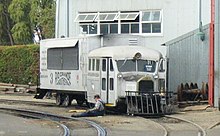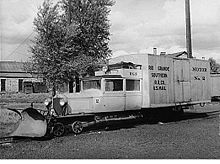Rio Grande Southern Railroad

The Rio Grande Southern Railroad (RGS) was a narrow-gauge railway line that ran between Durango and Ridgway in the western part of the US state of Colorado .
The RGS, which existed between 1890 and 1952 , was best known for its idiosyncratic vehicles, the so-called Gallopping Geese , a kind of cross between a car and a railway wagon.
history
The company was founded in 1889 and just two years later the 280 km long route over four passes was completed. Hopes of profiting from the silver boom turned out to be deceptive after the Silver Purchase Act was withdrawn . The railway had to file for bankruptcy due to the loans taken out for the construction. In 1893, the Denver and Rio Grande Railroad took control of the company. It continued to exist as a separate company on paper, but was actually operated as a division of D&RG. During its entire existence, it has never been able to generate enough income to pay interest on the bonds or to pay a dividend. In 1942 the company was bought by the Defense Supplies Corporation, as the route was needed to transport uranium from the mines at Vanadium.
In the period that followed, the already bad situation of the railway became even worse due to floods and washouts, losses of important customers, so that on December 27, 1951 the last train left on the line.
route
The route ran over the Dallas Divide west of Ridgway via Placerville and over the Lizard Head Pass (10,222 feet = 3,116 m) north of Rico . The most famous structure on the route was the Ophir Loop near Ophir . There the route in a narrow mountain valley had been led in several spiral loops over several large trestles in order to gain height. Then the tracks ran to Dolores over the plateau to Mancos and down to Durango.
Galloping Goose
During the economic crisis ( 1929 to 1941 ) it became difficult to maintain economic railway operations in mountainous terrain. The RGS then made seven conversion vehicles, the front part of which came from a road vehicle (bus or truck) and the rear part from a freight wagon. These unique constructs were called "Gallopping Geese", galloping geese. All but one of the "geese" ever built still exist today.
| Goose | Construction year | Type | Today's location |
|---|---|---|---|
| number 1 | 1931 | Buick | Replica in the Ridgway Railway Museum |
| No. 2 | 1931 | Buick | Colorado Railroad Museum |
| No. 3 | 1932 | Pierce-Arrow | Knott's Berry Farm |
| No. 4 | 1932 | Pierce-Arrow | Telluride |
| No. 5 | 1933 | Pierce-Arrow | Dolores (Colorado) |
| No. 6 | 1934 | Pierce-Arrow | Colorado Railroad Museum |
| No. 7 | 1936 | Buick | Colorado Railroad Museum |
Web links
- www.gallopinggoose.org ( Memento of February 6, 2007 in the Internet Archive )
- Rio Grande Southern historical information
- Route map



